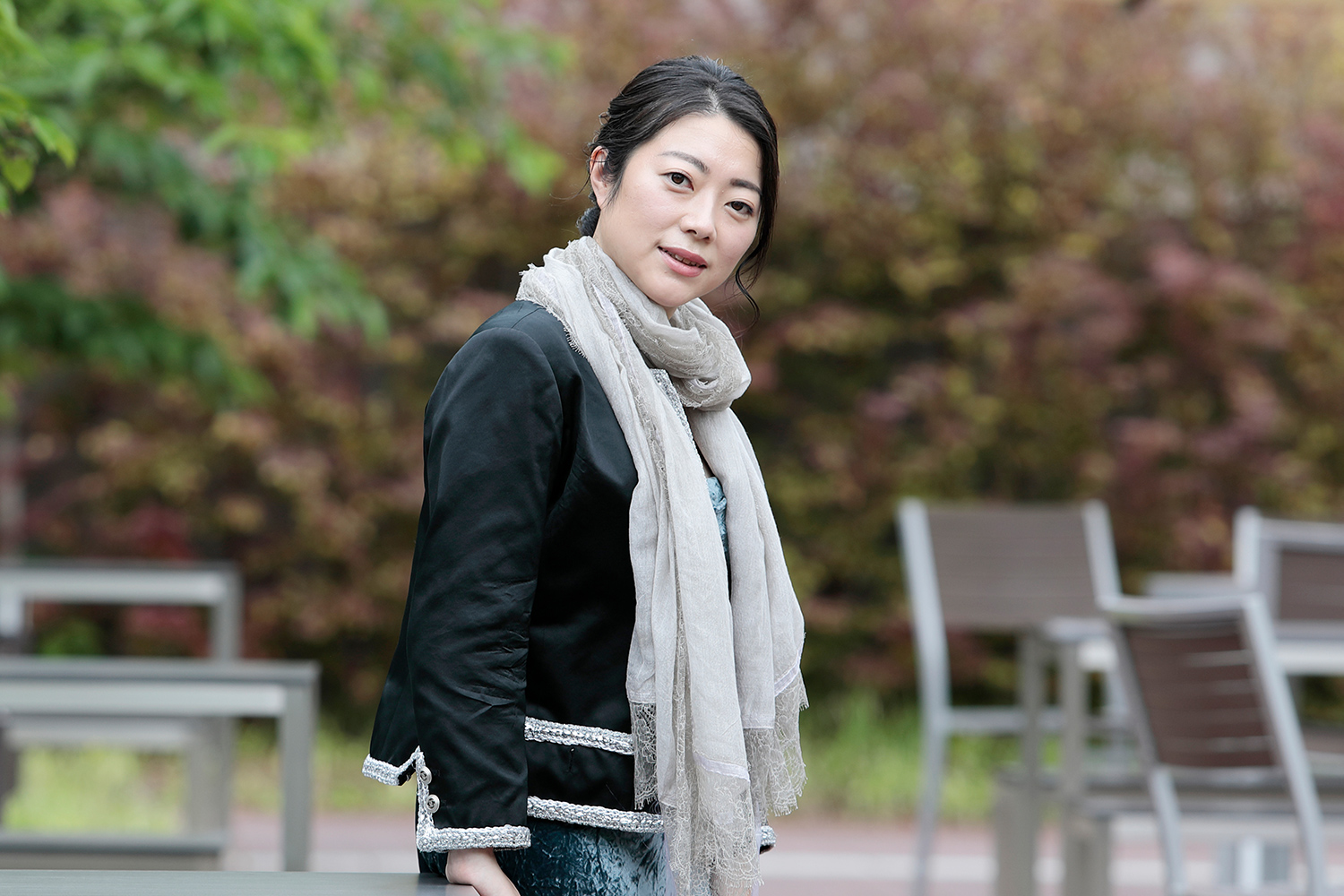STORY #3
Dialogues with
social Activists
Kyoko Tominaga, Ph.D.
Associate Professor, College of Social Sciences
To realize a Society where
Everyone Can live comfortably
As we walk around the streets of Tokyo, we often encounter political demonstrations. Some are against war, some are against nuclear power plants, and some are against racism and discrimination against minorities. In a single demonstration, we may see participants carrying banners with details about different issues. Gathering people to make political statements and show off the numbers of supporters to those in power is quite common in many cities around the world, and we can see the same happening in Tokyo.
However, according to Kyoko Tominaga, an associate professor of social movement studies at Ritsumeikan University, people’s views on political demonstrations differ greatly between Japan and Western countries. In her book, “Introduction to Selfishness for Everyone (Minna-no Wagamama Nyumon by Sayusha)”, Tominaga cites the results of ISSP (International Society Survey Program) survey, which states that fewer people have ever participated in demonstrations in Japan than in Western countries. Moreover, the research project conducted by Tominaga and other two researchers (Prof. Yusuke Kanazawa from Ritsumeikan University and Prof. Haruya Sakamoto from Kansai University) shows that the view of about half of the people in Japan regarding demonstrators is often not favorable. This does not mean that the Japanese are less interested in politics or more satisfied with it than people in other countries. In fact, more than one-third of the survey respondents have at some point participated or shown their interested to signature-collecting campaigns or donations to the government. It just means that there are more than a few people who have negative feelings toward demonstrations, where participants criticize the government in front of the public. The survey result shows that some of those who have negative opinions about demonstrations are somewhat afraid of them, while others are skeptical about whether they really lead to the improvement of social problems.
Tominaga suggests that one of the reasons for this attitude is that modern Japan had tended to be recognized as a homogenous society. Assuming that a group of people have similar values and are in a similar economic condition, it might to be unacceptable that only a few people are loudly advocating something on the public street. The basic idea in this type of community is, “everyone else is putting up with something, so why can’t you?” However, homogeneity is not the case in the present-day Japan, in which a lot of different values, economic conditions, and lifestyles have become evident. Claiming that I am different from you is simply an acknowledgement of a fact, not selfishness. In spite of this situation, why is there still a difference in the way of thinking between those who participates in movements and those who do not? Tominaga, who is not an activist herself, has been exploring the mindset and lifestyles of the protestors through inquiring surveys.
“I first became interested in social movements when I was a university student. I was an undergraduate student in the Faculty of Economics at that time and couldn’t fit in student life, so I joined an election campaign for non-political reasons,” Tominaga recalls. “But the candidate I was supporting then was not elected. Having been unable to send the person I supported to the political circle, I started to think about how we could have our opinions reflected in politics.”
That experience made her visit the sites of social movements; however, there was a kind of atmosphere that was unique to those places, and she found it was difficult to discuss something directly related to the prerequisite for the movement such as why the nuclear power plants should be shut down. Also, for a young woman of about 20 years old at that time, participating in male-oriented demonstrations was not an easy task. However, many of the participants were open-minded individuals, and when she asked them why they were participating or what motivated them, most of them answered her quite frankly. Therefore, she became more interested in the people who participated in the movements and the culture fostered by them, rather than the social movements themselves.
Tominaga’s first research topic was the 34th G8 Summit held at the lakeside of Lake Toya in Hokkaido in July 2008. Many activists opposed to political and economic globalization gathered in Hokkaido from all over Japan and other countries. Tominaga, who was a graduate student, made appointments with people in Hokkaido who agreed with or actively involved in this protest, and interviewed them in detail not only about their motives and arguments, but also about their backgrounds and lifestyles.
The people who came to the G8 protest were all of different nationalities, ages, and genders. Their original activities varied from labor issues to environmental issues to minorities’ rights issues. To welcome these various people, the local activists of Hokkaido set up an activist camp and let them stay there. “It is not easy to live together with people who have different attributes and are dealing with different issues on a daily basis,” Tominaga explains. “What is justice to one person may not be justice for someone else. Figuring out how to make decisions among different people is itself a social movement.” For instance, the behavior of people who were concerned about environmental issues might raise the awareness of other people about waste separation. What to do with the toilets of sexual minorities was an unavoidable issue in their daily lives. Even for a single recreational activity to build relationships among participants, they had to come up with rules that people with disabilities or children could enjoy together. Behind the protests against the summit and government leaders, they were making rules to solve the inequity and lack of understanding among themselves and to live together. Tominaga recalls that she regarded this duality interesting.

The next topic Tominaga was interested in was the social movements that young people were engaged in. Young activists in Japan are often burdened with a special position in the media coverage of social movements and collective action itself. The media often emphasizes the image of “young people who are not interested in politics” and older activists sometimes see them as inexperienced and do not treat them as their equals.
Around the aftermath of the Great East Japan Earthquake in 2011, there was a growing momentum of opposition, regarded to be led mainly by young people, to several laws related to Japan’s security, including the national security bills. Those young activists called for constitutional government that adheres to the Constitution of Japan and the diplomacy through dialog rather than security by force.
SEALDs (Students Emergency Action for Liberal Democracy -s), an anti-war project launched in 2015 by students and young people in their 20s, had multiple projects not only in Tokyo but also in other areas such as Kansai and Tokai, and had a large number of supporters all over Japan. One of the main characteristics of the participants was that they tried to be stylish and attempted to rewrite the ‘old-fashioned’ and ‘dangerous’ image of Japanese social movements. They refrained from displaying banners of their original protest groups or cards with messages that were different from the topic of the demonstration. The lack of a specific leader, music by DJs, and calls and responses also contributed to the sense of unity among them. To dispel the image of demonstrations as scary and alien, musical instruments and costumes that are usually seen in other demonstrations were also avoided. On the other hand, there were young people who told Tominaga that they didn’t want to create such a ‘new’ style of social movements. However, regardless of the style of the collective actions, many young participants were concerned about how to overcome the strong sense of avoidance of social movements inherited from their parents’ generation, and how to recruit their friends and classmates who felt distanced from politics into the movement.
Although demonstrations are transient events, the relationships between the participants can lead to long-lasting collaboration. The long relationship with activists, beginning with the study of the protest against the G8, brought Tominaga mainly two findings. The first is that not all activists dedicate their entire lives to activism. But even if they stop taking collective action, life itself can still be a social movement. Some left the movement when they got married or had children. Some left because they endured burnouts from social movement organizations or communities. However, through the way they bring up their children and their marriage styles, they are able to reflect the principles of social movements in their daily lives, even when they leave their organizations and communities.
Her other finding was that even if people did not join a protest, they could still start a social movement in their daily life. After meeting activists in feminist movements such as #MeToo and #KuToo (a movement against the rules that only women are required to wear high-heels and pumps in Japanese workplaces) around 2017, she realized that she might also have been exposed to the oppression of being a woman herself. In this sense, she also realized that researching social movements and communicating about them through television and books could also be political activism and could sometimes empower people with wounds similar to herself and those who are oppressed but different from her.
Tominaga concludes, “when I published books, they were picked up by mass media and received positive responses from the audience. Owing to the people who told me that my research has helped them, I am starting to feel that I am doing something meaningful, and it is not a bad thing for a researcher to communicate through the media. I would like to think more positively about the place where I stand.”

- Kyoko Tominaga, Ph.D.
- Associate Professor, College of Social Sciences
- Specialties: Social Movement, Globalization, G7/G8 Summit, Protest Tourism, Activist Identity
- Research Themes: Activist Identity and Social Movement Culture Developed through the Everyday Life and Collective Actions by Activists. A Study of the Origins of Resistance to and Avoidance of Social Movements in Japan




























